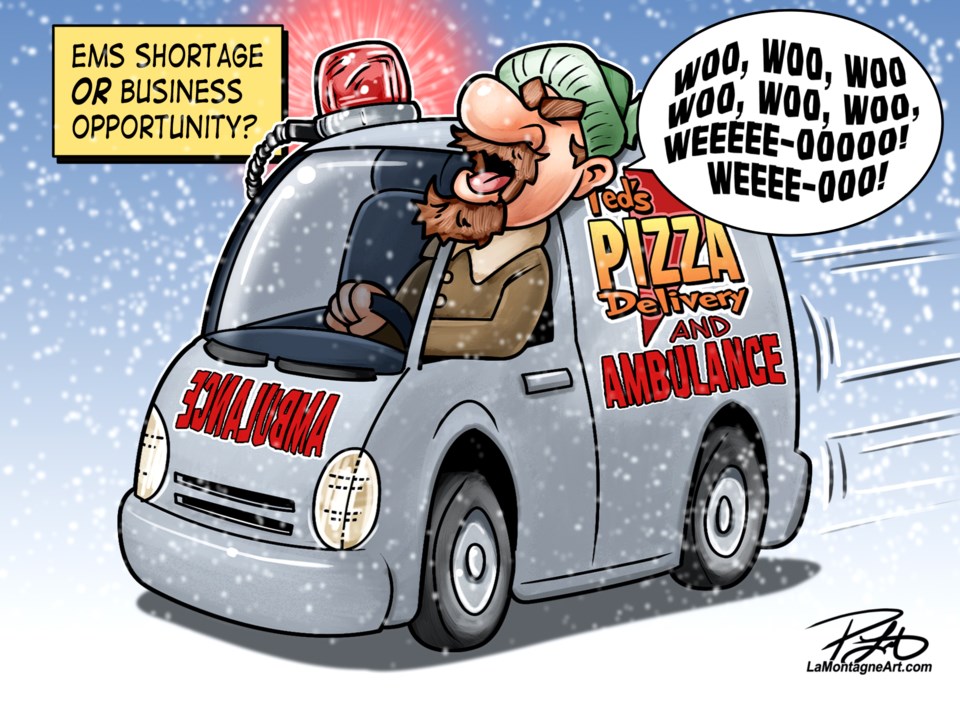The crisis of ambulance coverage in Alberta has surpassed a tipping point.
The existing system isn’t failing, but has failed.
Municipalities across the province regularly experience an ambulance shortage on a near daily basis as paramedics are called away from the communities they’re meant to help.
During the holidays, the Bow Valley was often without an ambulance as the regularly stationed crews were responding to emergencies, primarily in the Calgary-area.
Though the occasional shortage could be understood, the regularity has continued to increase.
The result has meant a mixture of longer waiting times for locals in need of medical attention and further strain on the firefighting departments in the valley, which already heavily rely on part-time responders.
Under the Alberta Health Services province-wide dispatch system, the closest ambulance is required to respond to each call, regardless of the patient’s priority. Ambulances are also required to stay with a patient until a hospital bed is available, leading to several hours being tacked on to a call.
It means when an ambulance from Banff or Canmore is called into Calgary, they’re more likely to spend the shift in the city opposed to the towns they’re meant to be in.
For the Bow Valley, however, it’s not the average small population centre.
As one of the major tourism hubs in Canada, the true population in the region is significantly larger than what the census data provides.
With Banff National Park and Kananaskis Country hosting millions of people annually and visitors flocking to the region to experience the beauty of the mountains, the call volume is inundating staff.
At a recent committee of the whole meeting for the Town of Canmore, statistics show the staggering toll it has taken locally.
For the first 11 months of 2021, Canmore Fire-Rescue had 305 of its 719 service calls be for medical. Of those, firefighters were on the scene 65 per cent of the time for medical calls. According to the department’s statistics, ambulances averaged a response time of about seven minutes and 15 second after fire crews had responded.
Without ambulances regularly stationed in communities, those times are only likely to increase.
At the Dec. 7 Canmore council meeting, statistics showed the first nine months of 2021 had Canmore paramedics responding to 1,237 calls with only 46 per cent being local.
That number has steadily increased in recent years, as paramedics are more frequently being called to other communities.
While paramedics are elsewhere assisting patients, locally it means longer response times.
In July, a 26-year-old man rode his bike into a pole at high speed. The closest ambulance was in Banff and arrived after about 20 minutes, though trained fire crews with basic life support skills arrived first.
A Dec. 18 collision on Highway 93 South had six ambulances attend the scene to help with seven injured patients. One of the ambulances came as far as Priddis, roughly 160 kilometres from the collision.
The extra stress placed on fire crews also means an additional financial burden is dumped at the door of municipalities, as local taxpayers cover firefighting costs.
Canmore council has requested a meeting with senior leadership from Alberta Health Services to discuss the issue. Banff council is also seeking similar resolution, while one of the most pressing topics at the Alberta Municipalities annual conference in November was the ambulance situation.
The Health Sciences Association of Alberta – a union of healthcare workers that includes paramedics – has been consistently vocal in providing data on when a community is without an ambulance.
While municipalities would take action more quickly – with the first paragraph of the Municipal Government Act emphasizing to “create and sustain safe and viable communities” – it is ultimately up to the province to aid in a positive change.
The can has been kicked down the road too many times.
The time for action is necessary.




